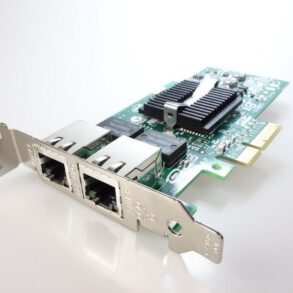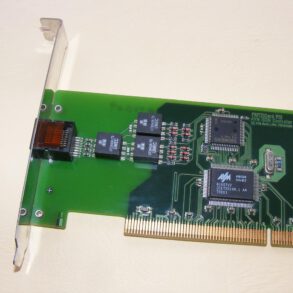Linksys WMP54G Wireless PCI Adapter. linksys.com
PCI stands for “Peripheral Component Interconnect, ” an industry standard for connecting devices to a computer’s central processor. PCI works by establishing a common interconnect called a bus that all connected devices share for communication. PCI is the most common interconnect used in desktop personal computers.
A PCI wireless adapter card connects to a desktop computer’s PCI bus. Because the PCI bus is contained inside the computer, the unit must be opened and the wireless network adapter installed inside.
An example of a PCI wireless adapter card, the Linksys WMP54G is shown above. This unit is more than 8 inches (200 mm) long in order to accommodate the standard connection strip required to electrically join to the bus. The unit attaches and fits snugly inside the PCI, although the wireless adapter card antenna protrudes out the back of the computer.
Wireless PC Card Adapter for Notebook Computers
Linksys WPC54G Notebook PC Card Adapter. linksys.com
A PC Card adapter joins a notebook computer to the network. The PC Card is a device approximately the width and height of a credit card compatible with the PCMCIA hardware interface standard.
The Linksys WPC54G shown above is a typical PC Card network adapter for notebook computers. This adapter contains a very small built-in Wi-Fi antenna to provide wireless capability. It also features built-in LED lights that display the device status.
PC Card devices insert into a slot on the side of a notebook computer. Wireless adapters like the one shown typically protrude a small amount from the side of the computer; this allows Wi-Fi antennas to transmit without interference. In contrast, wired Ethernet PC Card adapters insert fully inside the computer.
Given the small space they fit into, PC Card adapters become very warm during normal operation. This is not a major concern as the adapters are designed to withstand heat. However, notebook computers provide an eject mechanism to remove PC Card adapters when not in use to protect them and possibly extend their life.
Wireless USB Network Adapter
Linksys WUSB54G Wireless USB Network Adapter. linksys.com
The Linksys WUSB54G shown above is a typical WiFi . These adapters connect to a standard USB port available on the back of most newer computers. In general, USB network adapters are not much larger in size than PC Card adapters. Two LED lights on the adapter indicate its power and network link status.
Installation of a wireless USB adapter is simple. A short USB cable (normally included with the unit) joins the adapter to the computer. These adapters do not require a separate power cord, as the same USB cable also draws power from the host computer. The USB adapter’s wireless antenna and circuitry remain external to the computer at all times. On some units, the antenna can be adjusted manually to improve WiFi reception. The accompanying device driver software serves an equivalent function as in other types of network adapters.
Some manufacturers market two kinds of wireless USB adapters, a “basic” model and a “compact” model designed for travelers. Their small size and easy setup make these adapters an attractive choice for those who want to simplify their network setup.
Linksys WET54G Wireless Ethernet Bridge. linksys.com
A converts a wired Ethernet device for use on a wireless computer network. Wireless Ethernet bridges and USB adapters are both sometimes called wireless media adapters as they enable devices for WiFi utilizing Ethernet or USB physical media. Wireless Ethernet bridges support game consoles, digital video recorders and other Ethernet-based consumer devices as well as ordinary computers.
The Linksys WET54G Wireless Ethernet Bridge is shown above. It is only a bit larger than Linksys’ wireless USB adapter.
True network bridge devices like the WET54G do not require device driver software installation in order to function, simplifying installation. Instead, network settings for the WET54G can be made through a browser-based administrative interface.
Like USB adapters, wireless Ethernet bridges can draw their power from the main cable connected to the host device. Ethernet bridges require a specialized Power over Ethernet (PoE) converter to make this work, however, whereas this functionality is automatic with USB. Without a PoE add-on, wireless Ethernet bridges need a separate power cord.
Wirelss Ethernet bridges commonly feature LED lights. The WET54G, for example, displays lights for power, Ethernet and Wi-Fi status.
Wireless CompactFlash Card Adapter for PDAs
Linksys WCF54G Wireless Compact Flash. linksys.com
Wireless CompactFlash (CF) cards like the Linksys WCF54G shown above are designed for use in Pocket PC devices running the Microsoft Windows CE operating system. These adapters enable PDA devices for standard Wi-Fi networking.
Like PC Card adapters for notebook computers, wireless CompactFlash cards fit into a slot on the side or back of a PDA. The portion of the device containing the Wi-Fi antenna and LED lights protrudes from the PDA.




